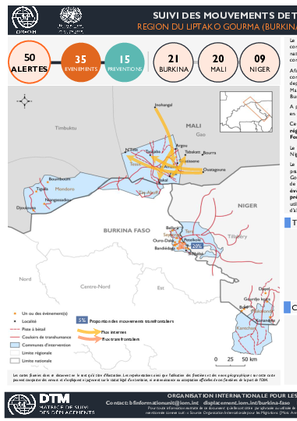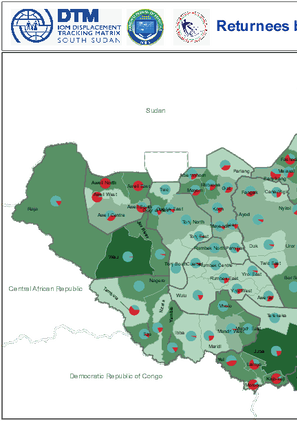-
Countries
-
Data and Analysis
-
Special Focus
-
Crisis Responses
Contact
DTM Nigeria, AllUsersInDTMNigeria@iom.int
Location
Nigeria
Activity
- Site Assessment
- Mobility Tracking
Period Covered
Aug 30 2021 -Oct 15 2021
A site assessment is a sub-component of mobility tracking. It aims to collect data on population presence, living conditions and needs in a particular displacement site or community.
Population Groups
Survey Methodology
Unit of Analysis Or Observation
Type of Survey or Assessment
Keywords
Geographical Scope
Administrative boundaries with available data
The current dataset covers the following administrative boundaries

Contact
DTM Nigeria, AllUsersInDTMNigeria@iom.int
Language
English
Location
Nigeria
Period Covered
Dec 13 2021
Dec 19 2021
Activity
- Event Tracking
- Mobility Tracking
Between 13 and 19 December 2021, a total of 5,791 movements were recorded in the states of Adamawa and Borno. The recorded movements consisted of 5,285 arrivals and 506 departures. Arrivals were recorded at locations in Askira/Uba, Bama, Biu, Damboa, Gwoza, Hawul, Kala/Balge, Monguno and Ngala Local Government Areas (LGAs) of the most conflict-affected state of Borno and in Girei, Gombi, Hong, Lamurde, Maiha, Michika, Mubi South, Song, Yola North and Yola South LGAs of Adamawa.
Contact
DTM Nigeria, AllUsersInDTMNigeria@iom.int
Location
Nigeria
Activity
- Mobility Tracking
- Baseline Assessment
Period Covered
Aug 30 2021 -Oct 15 2021
A baseline assessment is a sub-component of mobility tracking. It aims to collect data on IDP, migrant or returnee population presence in a defined administrative area of the country.
Population Groups
Survey Methodology
Unit of Analysis Or Observation
Type of Survey or Assessment
Keywords
Geographical Scope
Administrative boundaries with available data
The current dataset covers the following administrative boundaries

Contact
DTM Nigeria, AllUsersInDTMNigeria@iom.int
Language
English
Location
Nigeria
Period Covered
Aug 30 2021
Oct 15 2021
Activity
- Mobility Tracking
- Baseline Assessment
In response to the need for accurate and up-to-date information on human mobility and forced displacement in north-east Nigeria, IOM activated its Displacement Tracking Matrix (DTM) to support the Government and the humanitarian community with
multi-layered data on the numbers, trends, status, locations and needs of populations affected by the on-going conflict in north-east Nigeria. This dashboard provides key figures from Round 39 of assessment, conducted from 30 August to 15 October 2021.
In Round 39, a total of 2,200,357 Internally Displaced Persons (IDPs) were identified in 452,363 households. This signified an
increase of less than 1 per cent (or 17,744 individuals) compared to Round 38 when 2,182,613 IDPs were recorded (July 2021).

Contact
DTM Nigeria, AllUsersInDTMNigeria@iom.int
Language
English
Location
Nigeria
Period Covered
Aug 30 2021
Oct 15 2021
Activity
- Mobility Tracking
- Baseline Assessment
In response to the need for accurate and up-to-date information on human mobility and forced displacement in north-east Nigeria, IOM activated its Displacement Tracking Matrix (DTM) to support the Government and the humanitarian community with
multi-layered data on the numbers, trends, status, locations and needs of populations affected by the on-going conflict in north-east Nigeria. Round 39 of assessment was conducted from 30 August to 15 October 2021.
During Round 39, IDP assessments were conducted in 2,381 locations (up from 2,380 locations in Round 38). Assessed locations included 309 camps and camp-like settlements (no change since Round 38) and 2,072 locations where internally displaced persons lived among host communities (up from 2,071 in Round 38). The purpose was to better understand the gaps in services provided and the needs of the affected population. Site assessments included an analysis of sector-wide needs, shelter and non-food items, water, sanitation and hygiene (WASH), food and nutrition, health, education, livelihood, security, communication and protection.
This dashboard presents key findings from these site assessments. DTM identified 879,237 IDPs living in the 309 assessed sites. Eighty-one per cent of IDPs were women and children, 67 per cent of IDPs cited tarpaulin as the most needed shelter material, while 47 per cent of IDPs cited blanket/mat as the most needed NFI, 14 per cent of IDPs do not have access to regular medication, and 23 per cent of IDPs do not have access to food support. In 89 per cent of the sites surveyed, IDPs cited food as the main unmet need.

Contact
DTM Nigeria, AllUsersInDTMNigeria@iom.int
Language
English
Location
Nigeria
Period Covered
Aug 30 2021
Oct 15 2021
Activity
- Mobility Tracking
- Baseline Assessment
This document contains a list of the 309 sites assessed during Round 39 of DTM's Mobility Tracking assessments, conducted between 30 August and 15 October 2021. For each site, the document provides the Site I.D., the Site Name, the State, LGA and Ward of the site, as well as the number IDPs present in the site.

Contact
DTM Nigeria, AllUsersInDTMNigeria@iom.int
Language
English
Location
Nigeria
Period Covered
Aug 30 2021
Oct 15 2021
Activity
- Mobility Tracking
- Baseline Assessment
This document contains a list of the 780 wards in which Round 39 of DTM's Mobility Tracking assessments, conducted between 30 August and 15 October 2021, was carried out. The document provides the name of the assessed wards, the State and LGA in which the wards are located, as well as the number of IDPs identified in each ward.

Contact
DTM Nigeria, AllUsersInDTMNigeria@iom.int
Language
English
Location
Nigeria
Period Covered
Aug 30 2021
Oct 15 2021
Activity
- Mobility Tracking
- Baseline Assessment
This report, which presents the results from Round 39 of Displacement Tracking Matrix (DTM) assessments carried out by the
International Organization for Migration (IOM), aims to improve the understanding of the scope of internal displacement, the
plight of returnees and the needs of the displacement affected populations in north-east Nigeria. The report covers the period
from 30 August to 15 October 2021 and reflects the trends from the six states in Nigeria’s north-east geopolitical zone. This
zone is the most affected by the conflict and consists of the following states: Adamawa, Bauchi, Borno, Gombe, Taraba and Yobe.
In Round 39, a total of 2,200,357 Internally Displaced Persons (IDPs) were identified in 452,363 households. This signified an
increase of less than 1 per cent (or 17,744 individuals) compared to Round 38 when 2,182,613 IDPs were recorded (July 2021).
The number of IDPs recorded during Round 39 also increased by 9,164 individuals or less than 1 per cent compared to Round
37 when 2,191,193 IDPs were identified (May 2021). When comparing the number of IDP individuals between Round 39 and
Round 34 (September 2020), the number of IDPs in north-east Nigeria has increased by almost 3 per cent or 56,222 individuals
during the past year.
Furthermore, 1,943,445 returnees were recorded in the DTM Round 39 assessment.1 This number represents an increase of
25,382 individuals or more than 1 per cent compared to Round 38 when 1,918,063 returnees were recorded (July 2021).
During Round 39, IDP assessments were conducted in 2,381 locations (up from 2,380 locations in Round 38) with the purpose of understanding better the gaps in services provided and the needs of the affected population. Site assessments included an analysis of sector-wide needs, shelter and non-food items, water, sanitation and hygiene (WASH), food and nutrition, health, education, livelihood, security, communication and protection.

Contact
DTM Burkina Faso, bfinformationunit@iom.int
Language
French
Location
Burkina Faso
Period Covered
Oct 01 2021
Oct 31 2021
Activity
- Event Tracking
- Other
- Survey
- Flow Monitoring Survey
- Flow Monitoring
- Mobility Tracking
Afin de mieux comprendre les tendances des mouvements transhumants et l’impact des fragilités sur les communautés transhumantes, l’OIM, au travers de sa Matrice de suivi des déplacements (DTM), a déployé depuis juin 2019 l’outil de suivi de la transhumance (Transhumance Tracking Tool – TTT) avec le Réseau Bilital Maroobe (RBM) et ses antennes d’organisations d’éleveurs pour faire le suivi des mouvements de transhumants au Burkina Faso.
Le TTT permet de comprendre les dynamiques liées à la transhumance transfrontalière entre le Burkina Faso, le Niger et le Mali. Il combine trois composantes : la cartographie, le comptage et l’alerte.
Le système d’alerte a pour objectif de recenser les évènements liés à l’utilisation des ressources naturelles, aux pratiques agro-pastorales, ainsi qu’aux désastres naturels dans la région transfrontalière des pays du Liptako-Gourma, de comprendre les modes de résolution de conflits existants et d’informer les autorités compétentes afin de réduire les tensions dans les communes d’intervention. Ce système permet de recenser les alertes liées à un évènement conflictuel (alerte évènement) ou à un mouvement massif ou inattendu de bétail (alerte prévention) qui pourrait provoquer un conflit. Ce rapport présente les données de l’outil d’alerte pour le mois d'octobre 2021.

